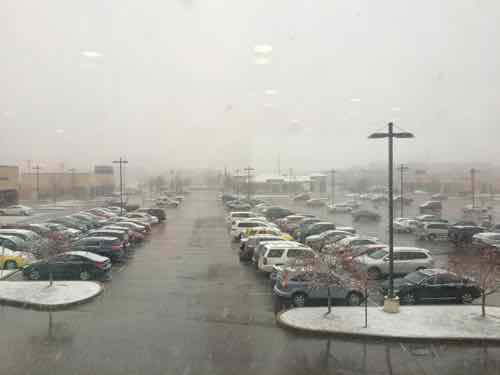Use Headlights During Low Visibility Conditions
Sunday I drove my husband to work so I could use our shared car for errands. As I was ready to return downtown from Ellisville (far West St. Louis County) I noticed the weather had suddenly gotten worse.

What amazed me is how many people driving on Clarkson & I-64 weren’t using their headlights, they must think headlights are only to help them see the road ahead. In low/reduced visibility conditions headlights help other drivers see your vehicle. Our car, like most newer cars, has daytime running lights, but headlights are more effective. Turning on headlights also turns on taillights, increasing visibility from behind.
On August 28, 2004 a law went into effect dealing with with the use of headlights at specific times, which motorists need to be reminded of during this time of year.
The definition in RSMo 307.020 dealing with when headlights are required was amended and new requirements were added to read: “When lighted lamps are required” means at any time from a half-hour after sunset to a half-hour before sunrise and at any other time when there is not sufficient light to render clearly discernible persons and vehicles on the highway at a distance of five hundred feet ahead. Lighted lamps shall also be required any time the weather conditions require usage of the motor vehicle’s windshield wipers to operate the vehicle in a careful and prudent manner as defined in section 304.012, RSMo. The provisions of this section shall be interpreted to require lighted lamps during periods of fog even if usage of the windshield wipers is not necessary to operate the vehicle in a careful and prudent manner. (Missouri Highway Patrol)
Illinois and other states have similar laws requiring headlight use. This time of year car windows & mirrors aren’t always clear: snow & ice on the outside or frost/fog on the inside of other vehicles reduce the chances those drivers will so you.
Remember, your lights help others see your vehicle.
— Steve Patterson
I was out driving yesterday and while visibility was generally good, there were some long open areas where blowing snow created near whiteout conditions and I had the same thoughts. Most people don’t think about anyone other then themselves which is proven time and time again when people don’t maintain openings between other cars and drive from opening to opening and creating congestion. It should be a no brainer that helping someone to see you by turning on your headlights not only makes driving safer for others, but also increases your own safety, yet so many people just don’t get it. I think that most people if asked think that they are good driver, even those who don’t use cruise control and can not maintain a steady and predictable speed.
Many cars now have auto headlights which come on at dusk and, more to the point of this post, come on when your wipers are activated. My last two cars had this feature and I could no longer go without. As for those who don’t get it…the USA would do themselves a favour by enacting some kind of national DRL legislation like the rest of the western world.
Unfortunately, many “automatic” systems have an override feature, and I see quite a few cluless people driving around without ANY headlights on, when they really should be (like after dark!), because they’ve accidentally switched the lights to “park” and the dashboard lights are still on. That’s the downside to automation, people simply don’t pay nearly as much attention, these days, to actually driving a multi-thousand-pound vehicle, instead, they’re focused on everything but the primary task at hand. While DRL’s (daytime running lights) would help, they’re neither as effective as regular headlights nor do they address the whole issue of inattention or incompetence behind the wheel!
I agree we need a national DRL law. Most cars with DRL do not have any sort of rear lighting except when the lights are switched on. My 1987 Volvo ollowed me to just leave the switch in the on position, so I had front & rear lights when driving. It only had a red rear fog light light I coukd switch on — very European.
My 2004 Toyota Corolla had automatic lights, they’d come on every time I drove into my parking garage. However, they wouldn’t have come on in the conditions I experienced on Sunday.